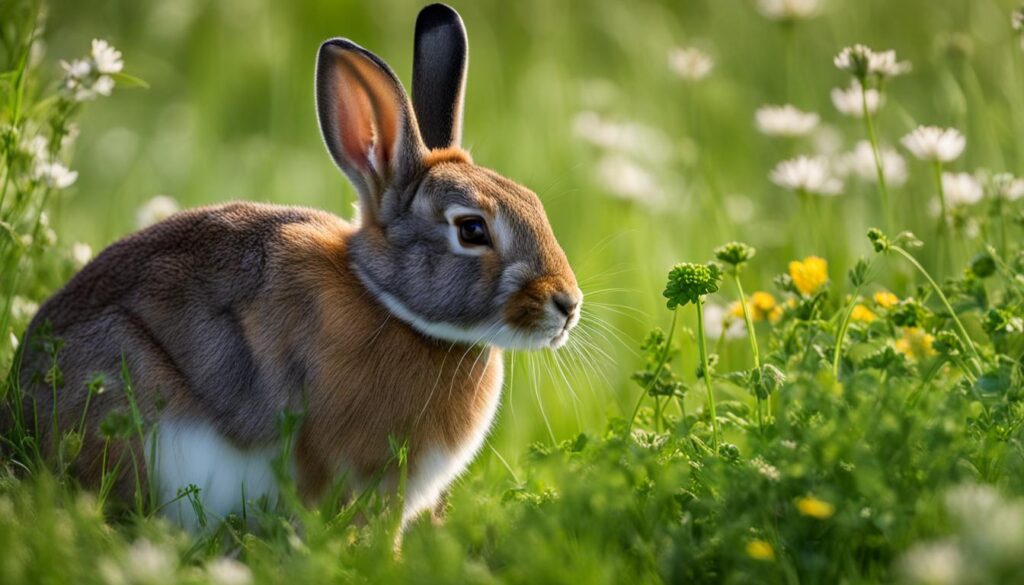The European rabbit, scientifically known as Oryctolagus cuniculus, is a highly adaptable animal that can be found in various habitats across the world. Native to north-western Africa, Spain, Portugal, and parts of Western Europe, rabbits have also been introduced to other regions such as the USA, Chile, and Australia.
Within Australia, rabbits were brought by colonists in the 18th century and quickly multiplied, reaching a population of over 20,000 individuals within just six years. These herbivorous creatures are most active from late afternoon to early morning and prefer short grassy areas with nearby shelter. Their diet includes crops, pastures, and young trees.
Rabbits are prolific breeders, with females capable of producing multiple litters each year, which contributes to their high population growth rate. However, they are also susceptible to diseases such as myxomatosis and rabbit haemorrhagic disease, which have had significant impacts on their populations.
While rabbits have a wide range of impacts on their habitats, including competition with native species for resources and damage to vegetation, they also provide benefits such as acting as a food source for predators and being a valuable resource during times of scarcity.
Key Takeaways:
- European rabbits are highly adaptable and can be found in various habitats worldwide.
- They were introduced to Australia by colonists and quickly multiplied.
- Rabbits prefer short grassy areas with nearby shelter.
- Their diet includes crops, pastures, and young trees.
- Rabbits are prolific breeders and susceptible to diseases.
Origin and Distribution of the European Rabbit
The European rabbit, scientifically known as Oryctolagus cuniculus, is native to north-western Africa, Spain, and Portugal. It has also been introduced to other regions, including the USA, Chile, and various parts of Western Europe. In Australia, rabbits were brought by colonists in the 18th century and quickly spread across the continent. Within 70 years, rabbits inhabited two-thirds of the continent, covering approximately 5.3 million square kilometers or 70% of southern Australia.
European rabbits are highly adaptable and can thrive in a range of environments, from subalpine areas to deserts, grasslands, and wet coastal plains. Human activities, such as livestock production, have also contributed to their distribution. In New South Wales, rabbits are found throughout most of the state, with approximately 8% having a high and detrimental population. They are often found in short grassy areas, including heavily grazed pastures, and can be a problem around gardens and farm buildings.
To gain a better understanding of the distribution of European rabbits in Australia, the table below provides a breakdown of their population in each state:
| State | Rabbit Population |
|---|---|
| New South Wales | High population in approximately 8% of the state |
| Victoria | Widespread distribution |
| Tasmania | Localized populations |
| South Australia | Widespread distribution |
| Western Australia | Localized populations |
| Queensland | Localized populations |
As seen in the table, the distribution of rabbits varies across different states in Australia. This information can help inform conservation efforts and targeted population control measures to manage the impact of European rabbits on the environment and agricultural activities.
Behavior and Social Structure of European Rabbits
The European rabbit exhibits a range of fascinating behaviors and has a distinct social structure. These characteristics contribute to their adaptability and survival in various habitats. Understanding their behavior and social dynamics is crucial for effective rabbit management and conservation efforts.
Daily Activity and Communication
European rabbits are most active during the late afternoon and early morning, although they can be active at any time if undisturbed or if their population numbers are high. They primarily communicate through smell, marking their territory with scent glands located on their chins and spraying urine to establish boundaries. Additionally, rabbits use visual cues as alarm signals, such as flashing their tails and thumping their hind feet to warn others of potential threats.
Social Structure and Reproduction
During the breeding season, social groups consisting of 7-10 rabbits form, led by a dominant buck and a dominant doe. These groups display a hierarchical structure, with aggressive interactions and territorial behavior. The breeding season varies depending on factors such as rainfall and the availability of high protein plants. Female rabbits, known as does, can produce multiple litters per year, with gestation periods lasting 29-35 days. The young, called kittens, are born blind and hairless, and the doe visits them several times a day for feedings. The presence of a dominant buck helps protect the warren and ensure the survival of the offspring.
Reproductive Potential
Rabbits have a remarkable reproductive capacity, with both males and females reaching sexual maturity at 3-4 months of age. They can breed at any time if there is sufficient short green feed available. Under favorable conditions, a female rabbit can produce 7-8 litters in a year. This high reproductive potential contributes to the rapid population growth of European rabbits and their ability to colonize new environments quickly.
| Rabbit Behavior | Rabbit Social Structure | Rabbit Breeding | Rabbit Communication |
|---|---|---|---|
| Rabbits are most active during late afternoon and early morning. | Social groups of 7-10 rabbits form, led by a dominant buck and doe. | Females can produce 7-8 litters per year under favorable conditions. | Rabbits communicate primarily through smell and visual cues. |
| They mark their territory with scent glands and urine spraying. | Social hierarchies and aggressive interactions are observed within groups. | Both males and females reach sexual maturity at 3-4 months of age. | Alarm signals include tail flashing and hind foot thumping. |
| Aggressive behavior and territoriality are common during the breeding season. | A dominant buck helps protect the warren and ensures offspring survival. | Gestation periods range from 29-35 days. | Rabbits use visual cues and scent marking for communication. |
European Rabbit Diet and Coprophagy
The European rabbit is herbivorous and has a diverse diet that includes crops, roots, pastures, young trees, and succulent plants. With an average body weight of 1.6 kg, rabbits can consume up to one-third of their own weight daily, with an average intake of 100-150g. But what sets rabbits apart from other herbivores is their unique digestive process, known as coprophagy.
“Coprophagy allows rabbits to extract additional protein and moisture from their food,” explains Dr. Smith, a rabbit expert. “During the day, rabbits produce soft pellets rich in nutrients, which they consume directly from the anus. This process enables them to achieve more complete digestion of fibrous plant material.”
The hard pellets observed on the ground are the result of this digestive process and are typically dropped during grazing periods. Interestingly, coprophagy also helps rabbits survive with minimal free water. By recycling their waste, rabbits can extract extra nutrients, ensuring efficient energy utilization.
Rabbit Digestive Process
To better understand the rabbit’s unique digestive process, let’s take a closer look at their digestive system:
| Part of Digestive System | Function |
|---|---|
| Stomach | Initial digestion of food |
| Small Intestine | Further breakdown of food and nutrient absorption |
| Cecum | Large fermentation chamber where fiber is broken down by bacteria |
| Colon | Reabsorption of water and formation of hard fecal pellets |
| Rectum | Storage of hard fecal pellets and soft pellets for coprophagy |
The cecum, a specialized organ in the digestive system, plays a crucial role in the rabbit’s ability to extract nutrients from fibrous plant material. It houses bacteria that break down cellulose, a complex carbohydrate found in plant cell walls. Once the fibrous material passes through the small intestine, it enters the cecum for fermentation. The fermentation process allows the bacteria to break down the fiber into simpler compounds that can be absorbed by the rabbit.
Overall, the European rabbit’s diet and coprophagy adaptation showcase their remarkable ability to thrive on a variety of plant-based foods while efficiently extracting nutrients from their environment.
European Rabbit Habitat Preferences
The European rabbit, commonly known as Oryctolagus cuniculus, exhibits specific habitat preferences that contribute to its widespread distribution. These rabbits are highly adaptable and can thrive in various climatic regions, including subalpine areas, stony deserts, subtropical grasslands, and wet coastal plains. However, they generally avoid large cultivated areas, forests, floodplains, and black soil country. European rabbits are most commonly found in short grassy areas, both natural and resulting from heavily grazed pastures, where they can graze on a variety of plants.
While rabbits can adapt to a wide range of habitats, they thrive in areas that provide nearby shelter, such as blackberries or fallen logs. These sheltered areas allow the rabbits to find protection from predators and harsh weather conditions. Additionally, rabbits tend to favor areas with an abundance of short grass, as it provides them with easy access to their preferred food sources. They are often found in areas with a combination of short grass and nearby shelter, creating an ideal habitat for their survival and reproduction.
In heavily grazed pastures and gardens, where short grass is abundant, European rabbits may become a problem due to their feeding habits and potential damage to vegetation. However, their preference for short grassy areas also makes them beneficial in certain ecosystems. These rabbits create warrens that serve as homes for other species, including echidnas, goannas, and brushtail possums. Additionally, rabbits act as a food source for birds of prey, playing a crucial role in the natural food chain.
Rabbit Habitat Preferences Summary:
- European rabbits adapt to a wide range of habitats, including subalpine areas, stony deserts, subtropical grasslands, and wet coastal plains.
- They prefer short grassy areas, both natural and resulting from heavily grazed pastures.
- Nearby shelter, such as blackberries or fallen logs, is important for their protection and survival.
- Rabbits may become a problem in heavily grazed pastures and gardens due to their feeding habits.
- They create warrens that serve as homes for other species and act as a food source for birds of prey.
| Habitat Preferences | Implications |
|---|---|
| Short grassy areas | Preferred for feeding on a variety of plants, but may cause damage in heavily grazed pastures and gardens |
| Nearby shelter | Provides protection from predators and harsh weather conditions |
| Creation of warrens | Provides homes for other species, contributing to ecosystem biodiversity |
| Food source for birds of prey | Plays a crucial role in the natural food chain and predator-prey relationships |
European Rabbit Distribution and Impact in Australia
The European rabbit has established a widespread distribution in Australia, covering approximately 70% of southern Australia, which translates to around 5.3 million square kilometers of land. Their adaptability allows them to thrive in various environments, including subalpine areas, deserts, grasslands, and wet coastal plains. Rabbits are often found in short grassy areas, such as heavily grazed pastures, and they can become a problem around gardens and farm buildings.
This extensive distribution has significant implications for Australian ecosystems. Rabbits compete with native species for resources, causing damage to vegetation through grazing. Their presence also contributes to soil erosion, and they have been associated with declines in threatened plant species and ecological communities. The impacts of rabbits on the environment are substantial, and the agricultural industry incurs an annual cost of over $200 million due to their pest status. It is important to note that rabbits do provide some benefits, such as being a food source for predators and creating warrens that are utilized by other species.
| Impact | Effect |
|---|---|
| Competition for resources | Native species are outcompeted by rabbits for food and habitat. |
| Vegetation damage | Rabbits graze on vegetation, leading to changes in plant communities and ecosystem dynamics. |
| Soil erosion | Rabbits contribute to soil erosion through their digging activities. |
| Threatened species decline | Rabbits have been associated with declines in threatened plant species and ecological communities. |
| Agricultural cost | The presence of rabbits as a pest animal costs the agricultural industry over $200 million annually. |
The distribution and impact of European rabbits in Australia highlight the need for effective management strategies. Conservation efforts focus on preserving habitat, managing the impacts of diseases, and implementing population control measures. It is crucial to strike a balance between containing rabbit populations and minimizing their negative effects on ecosystems and agriculture.
Diseases Impacting European Rabbit Populations
The European rabbit populations have faced significant challenges due to several diseases that have had a severe impact on their numbers. Two major diseases that have affected rabbit populations are myxomatosis and rabbit haemorrhagic disease. These diseases have caused significant declines in rabbit populations at different periods, disrupting the balance of predator-prey relationships and ecosystem dynamics.
Myxomatosis: Myxomatosis is a viral disease that was introduced as a biological control agent in the 1950s. It causes high mortality rates in rabbits, leading to death within 8-12 days after infection. The disease is primarily transmitted through biting insects like fleas and mosquitoes. Myxomatosis has had a profound impact on rabbit populations, resulting in population declines and changes in predator-prey dynamics. However, over time, rabbits have developed some level of immunity to the disease.
Rabbit Haemorrhagic Disease: Rabbit haemorrhagic disease (RHD) is another viral disease that has impacted rabbit populations. It was first introduced in the 1990s and caused rapid and widespread mortality among rabbits. RHD leads to death within hours of infection and is highly contagious. The disease is primarily transmitted through direct contact between infected rabbits or indirectly through contaminated materials. RHD has further reduced rabbit populations and had significant ecological consequences.
“These diseases have been devastating for rabbit populations, with high mortality rates and significant declines in numbers. The impacts of myxomatosis and rabbit haemorrhagic disease extend beyond rabbit populations, affecting predator-prey relationships and ecosystem processes.”
The management and control of these diseases remain ongoing challenges. Efforts have been made to develop vaccines and implement control measures to reduce the spread and impact of these diseases. However, it is essential to monitor and adapt management strategies to effectively address the health of European rabbit populations and mitigate the ecological consequences of these diseases.
| Disease | Characteristics | Impact |
|---|---|---|
| Myxomatosis | Viral disease transmitted by biting insects | High mortality rates, death within 8-12 days, changes in predator-prey dynamics |
| Rabbit Haemorrhagic Disease | Viral disease transmitted through direct contact or contaminated materials | Rapid and widespread mortality, death within hours, significant population declines |
Predation and Parasites of European Rabbits
European rabbits face predation from a variety of animals, including foxes, dingoes, cats, dogs, birds of prey, ravens, goannas, and snakes. These predators pose a significant threat to rabbit populations and can cause substantial losses. Birds of prey such as the wedge-tailed eagle, goshawks, falcons, and barn owls are known to prey on rabbits, particularly in areas where their presence has led to a decline in native fauna. Predation affects both healthy and starving rabbits, impacting their overall population.
Rabbits also contend with various parasites, although their external parasite load is relatively low. Fleas are the most common external parasites found on rabbits, including the European and Spanish rabbit fleas. These fleas can transmit diseases such as myxomatosis. Internally, rabbits can be affected by coccidiosis, a protozoal disease that can affect the liver or intestines, depending on the species of the parasite. Young rabbits are more susceptible to hepatic coccidiosis, while intestinal coccidiosis is less fatal.
| Type of Predators | Predator Examples |
|---|---|
| Land Predators | Foxes, dingoes, cats, dogs, goannas, snakes |
| Birds of Prey | Wedge-tailed eagle, goshawks, falcons, barn owls |
| Common Parasites | Description |
|---|---|
| Fleas | European and Spanish rabbit fleas |
| Coccidiosis | Protozoal disease affecting the liver or intestines |
Benefits and Impacts of European Rabbits
The European rabbit has both benefits and impacts on its surrounding environment. Despite their negative reputation as a pest species, rabbits do provide certain advantages. They create warrens that serve as shelter for other animals such as echidnas, goannas, and brushtail possums. Additionally, rabbits act as a food source for birds of prey, particularly in areas where their presence has led to a decline in native fauna.
However, the overall impacts of European rabbits are predominantly negative. They compete with native species for resources, leading to resource scarcity and potential declines in biodiversity. Rabbits also cause extensive damage to vegetation through their grazing activities, leading to changes in plant communities and reducing habitat quality for other species.
Their ability to breed prolifically and their capacity to thrive in a range of environments have contributed to their status as a costly pest vertebrate animal in Australia. The annual cost of managing rabbit populations exceeds $200 million. Efforts to control rabbit populations are necessary to mitigate their impacts on ecosystems and agriculture.
“Rabbits have become a major pest vertebrate animal in Australia, costing the agricultural industry over $200 million annually.”
| Benefits | Impacts |
|---|---|
| Rabbits provide warrens for other animals | Competition with native species for resources |
| Rabbits are a food source for birds of prey | Damage to vegetation through grazing |
Current Status and Conservation of European Rabbits
European rabbits face significant challenges in terms of population decline and the conservation efforts required to protect this species. The impact of rabbits on ecosystems and agriculture has led to their designation as a costly pest vertebrate animal in Australia, where they inhabit approximately 70% of southern Australia, covering an area of approximately 5.3 million square kilometers. To address their impact, various management strategies have been implemented, including the use of biological control agents, barriers, and targeted removal.
The management of rabbit populations is an ongoing challenge, as their adaptability and high reproductive rates make it difficult to control their numbers effectively. Disease outbreaks, such as myxomatosis and rabbit haemorrhagic disease, have had significant impacts on rabbit populations at various times. In response, conservation efforts are focused on managing the impacts of diseases, preserving suitable habitat, and implementing effective population control measures to protect native fauna and flora.
To ensure the successful conservation of European rabbits, it is crucial to understand their habits, behavior, and habitat preferences. This knowledge allows for the development of tailored management strategies that consider the specific needs of the species. By integrating measures that address population control, disease management, and habitat preservation, it is possible to strike a balance that minimizes the negative impacts of rabbits on ecosystems while providing effective conservation outcomes.
| Table 1: Management Strategies for European Rabbits | |
|---|---|
| Management Strategy | Description |
| Biological control agents | Introduction of natural predators or disease-causing agents to suppress rabbit populations |
| Barriers | Physical barriers, such as fences or netting, to prevent rabbits from accessing sensitive areas |
| Targeted removal | Culling or trapping of rabbits to reduce their numbers in specific areas |
| Habitat preservation | Protection and restoration of suitable rabbit habitat to ensure their long-term survival |
The conservation of European rabbits requires a multi-faceted approach that addresses both the ecological impacts of the species and the management of their populations. By implementing effective strategies and working collaboratively with stakeholders, it is possible to balance the needs of agriculture, native ecosystems, and the survival of European rabbits.
Conclusion
The European rabbit, with its adaptability and prolific breeding, has established populations in various regions, including Australia, where it has become a costly pest vertebrate animal. Rabbits have had significant impacts on ecosystems and agriculture, competing with native species for resources, causing damage to vegetation, and contributing to soil erosion. The population dynamics of rabbits have been influenced by diseases such as myxomatosis and rabbit haemorrhagic disease, resulting in population declines at certain times.
Conservation efforts for the European rabbit focus on managing their impacts, preserving habitat, and implementing effective population control measures. This includes the management of diseases, such as myxomatosis and rabbit haemorrhagic disease, as well as the use of biological control agents, barriers, and targeted removal. However, rabbit management remains a challenge, and their impacts on ecosystems and agriculture continue to be a concern.
Understanding the habits, behavior, and habitat preferences of European rabbits is crucial for effective management and conservation efforts. By studying their population dynamics and interactions with other species, we can develop strategies to mitigate their negative impacts and promote coexistence. Preserving habitat, managing diseases, and implementing effective population control measures are essential steps in ensuring the conservation of the European rabbit and the sustainability of ecosystems in which they reside.
FAQ
Where is the European rabbit native to?
The European rabbit is native to north-western Africa, Spain, Portugal, and various parts of Western Europe.
Where has the European rabbit been introduced?
The European rabbit has been introduced to regions such as the USA, Chile, and various parts of Western Europe.
How did rabbits become established in Australia?
Rabbits were brought to Australia by colonists in the 18th century and quickly multiplied, reaching a population of over 20,000 within 6 years.
What habitats do rabbits prefer?
Rabbits can be found in various habitats, including subalpine areas, deserts, grasslands, and coastal plains. They prefer short grassy areas with nearby shelter.
What do rabbits eat?
Rabbits are herbivorous and have a varied diet, including crops, pastures, and young trees. They can consume up to one-third of their own weight daily.
When are rabbits most active?
Rabbits are most active from late afternoon to early morning, with daily movements within 150-200 meters of their warren.
How frequently do rabbits breed?
Female rabbits can produce multiple litters per year, resulting in a high population growth rate. The breeding season varies depending on conditions.
What diseases impact rabbit populations?
Diseases such as myxomatosis and rabbit haemorrhagic disease have had significant impacts on European rabbit populations.
What predators do rabbits have?
Rabbits are preyed upon by various predators, including foxes, dogs, cats, birds of prey, and snakes.
What impacts do rabbits have on their habitats?
Rabbits can compete with native species for resources, cause damage to vegetation, and contribute to soil erosion. However, they also provide food for predators and can be a valuable resource in times of scarcity.
What is being done for the conservation of European rabbits?
Conservation efforts for European rabbits focus on managing their impacts on ecosystems, preserving habitat, and implementing effective population control measures.





